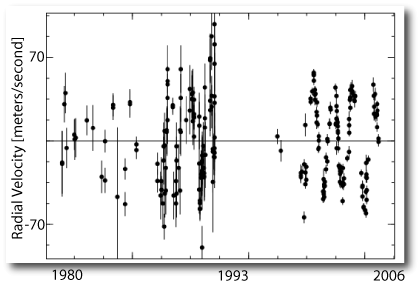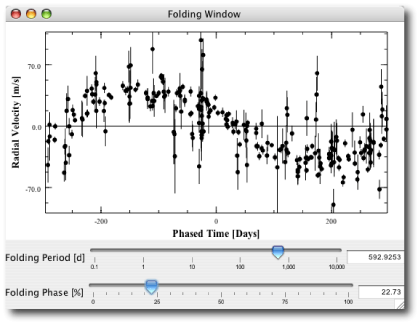
Image Source.
Several weeks ago, the planet count at the extrasolar planets encyclopedia notched up by one with the announcement by Artie Hatzes and his collaborators that Pollux (Beta Geminorum) is accompanied by a ~2-3 Jupiter mass planet on a 590 day orbit. This world has been under construction for a long time. The first published radial velocity data point for the star dates back to Nov. 15th, 1980, and Hatzes et al. brought 55 new radial velocities to the table to seal the detection. The planet was independently confirmed by Reffert et al., who (in a preprint posted July 7th) deliver an additional 80 high-precision velocities.

All told, there are now seven published datasets, and all are available on both the on-line and downloadable versions of the console. When folded together, at a 593 (1.6 year) period, a full quarter century’s worth of radial velocity data show the planet quite nicely.

After the Sun, Pollux is the 17th brightest star in the sky. It’s prominently visible both because it’s close (34 light years) and also because it’s an intrinsically bright K0III giant star. Pollux is about 1.9 times more massive than the Sun, and is already coming to the end of its life. It has left the main sequence, and is beginning its long trek up the red giant branch of the Hertzsprung Russell diagram.
In last Saturday’s post, I wrote about predictions of the core-accretion hypothesis with respect to planet formation. The ability to quickly build a Jovian-mass planet depends on the surface density of solid material in the protostellar disk. A lot of solids leads to rapid buildup of cores, and hence the ability of planets to achieve rapid gas accretion before the protostellar disk dissipates. (The spiral wave-induced evolution of marginally gravitationally stable disks leads one to expect that disk masses will correlate with the masses of the central stars, see this paper for a lot more discussion.) All other factors being equal, one expects that Jupiter-mass planets will be rarer around stars that have significantly less mass than the Sun, and that conversely, Jupiter-mass planets will be more common around planets of somewhat higher mass than the Sun. (Note that for really massive stars, the luminosity of the star itself will rapidly photo-evaporate the disk, which will cause problems for giant planet formation via core accretion).
Unfortunately, it gets increasingly harder to apply the radial velocity detection method to Main Sequence stars that are considerably more massive than the Sun. The higher temperatures of these stars lead to weaker spectral lines. Weaker spectral lines make it hard to get really accurate radial velocities. Higher mass stars also tend to be fast rotaters, which further smears out the lines, and they are often subject to pulsations which can mimic the radial velocity signature of an orbiting planet. Above about 1.3-1.4 solar masses, it thus becomes hard to survey main sequence stars for planets.
Luckily, however, a trick can be used to assess the planet frequency for high-mass stars. As a star that has ~1.5-3 solar masses ends its main-sequence hydrogen burning life, its core begins to contract and its outer layers swell up and cool down. The atmosphere of the star then regains the wealth of spectral lines that can be used to make accurate radial velocity measurments, and hence detect planetary companions. The core accretion theory predicts that planet hunting around such giant stars should be a highly profitable enterprise.
